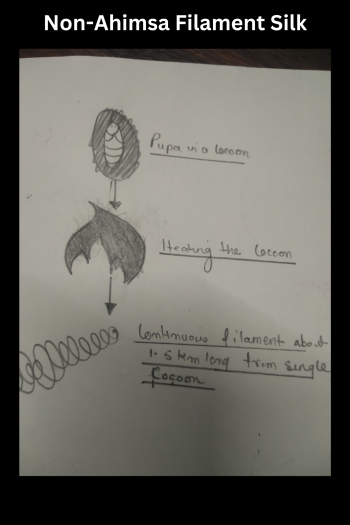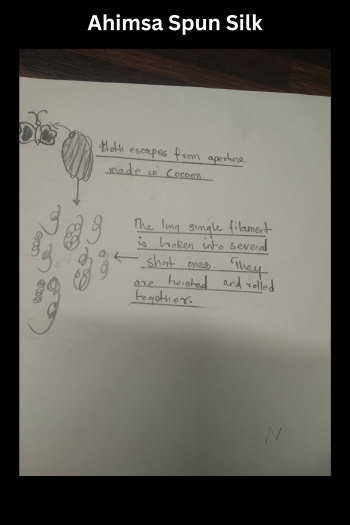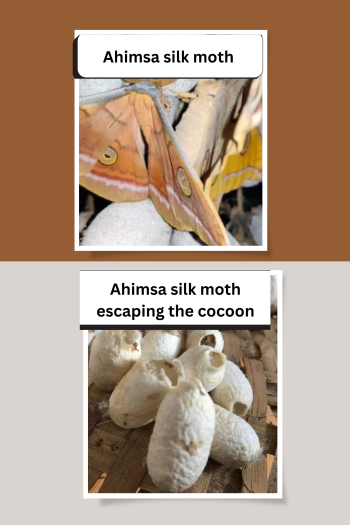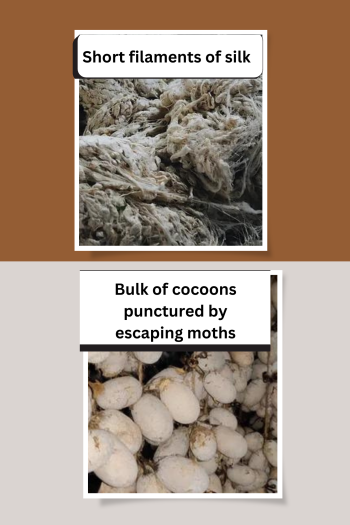Shopping Cart
Silk as they say, ‘Queen of textiles’ needs to be talked about at royal length. Every designer has a unique relationship with silk. My relationship with the long lush yarns is longstanding. I need a few episodes to cover all I have to say about silk and how I have used it in my designs. This blog will mainly focus on a special type of silk called Ahimsa/Peace Silk and the different kinds of silk I have used in my designs- many silk combination just bespoke to Olee. I have covered details on Sericulture and its practice in India in the blog Sericulture: Indie Resham facts and role of women.
Sericulture is cultivation of silkworms for production of silk and has existed in India since 15th century. It is one of our key indigenous agro-based industries. Sericulture in short is cultivating silkworms and extracting silk from them. These special silkworms feed on the selected food plants and spin cocoons as a ‘protective shell’ to continue life. The cocoons are boiled in hot water. This is done to kill the silk worm inside the cocoon so it does not get a chance to complete it’s life cycle by transforming into a moth which will pierce a hole in the cocoon and fly off. The cocoon remains intact by killing the pupa inside and the individual long fibers that make the cocoon are extracted and fed into the spinning reel. This is the commercial practice of sericulture and most widely practiced everywhere. About 10,000 silk worms are killed to make a single saree.
Making of conventional silk is disruptive for the natural life of a moth. Ahimsa Silk, also known as peace silk/cruelty-free silk/non-violent silk, refers to any type of silk that is produced without harming or killing the silk worms. (It is also, erroneously, called vegan silk. As an animal product, however, it is not vegan). Ahimsa silk is made on a very small scale as a cottage industry in India and it’s production supports a wide community of rural silk farmers (usually women), spinners (women) and weavers (women & men). Indian is the only producer of Ahimsa silk in the world.
Origin Of Ahimsa Silk: The creation and commercialisation of ahimsa silk is credited to Kusuma Rajaiah, a 60-year old government officer from Andhra Pradesh in India, who holds the patent and trademark for Ahimsa Silk. Inspired by Ghandi, Rajaiah applied his 40 years of sericulture experience and the theories behind the ahimsa way of life to the making of silk. The word “ahimsa” itself derives from Sanskrit and translates as “noninjury. He found that it was possible to create silk without killing the silk worms and began weaving ahimsa silk in 1990. In 2001 his company began marketing the silk and it continues to gain popularity both in India and abroad.
How is Ahimsa Silk Made: Ahimsa silk production is a humane alternative to this conventional silk production. It is only produced in India cottage industries. It can be produced from any type of silk. In this method, silk cocoons are only harvested and processed after the moth has hatched from the cocoon. The trees where the silkworms grow are not treated with insecticide or fungicide. The entire tree is covered with a fine net, to protect the caterpillars and leaves from other insects or birds. Organic cultivation has a positive impact on the size of the cocoon and the quality of silk thread.The moth secretes a liquid to dissolve a hole from which to hatch, breaking
the long, continuous silk fibre into shorter staples. These shorter staples must be spun together; just as wool or cotton staples are spun into yarn. The high sheen and lustre of the silk are exchanged for a thicker and more textured cloth. Peace Silk won’t use genetically modified silk worms, or such that lost their ability to fly or eat through generations of generations of breeding – and would face another type of death in starvation. This is common practice in conventional silk production as well.








Source of Ahimsa Silk: Ahimsa silk can be made from any type of silk. It is a process to be followed and not specific to any special type of silk. Ahimsa silk is called spun silk since it’s spun from short filaments resulting in a punctured cocoon. Non-ahimsa or regular silk is called filament silk, referring to the long and continuous filaments extracted from an intact cocoon boiled to kill the pupating moth inside. Eri and Balkal silks are pure ahimsa silk and cannot be extracted any other way. Eri silk is cultivated in Assam and is a beautiful smooth and strong silk. Balkal silk is very rare form of ahimsa silk since it is extracted from the stem that attaches the cocoon to the leaf. So silk worms are not killed in the process of extracting Balkal silk.
How to Identify Ahimsa Silk: Often like Matka silk, the fabric has texture and feels slightly coarse. This is because of spinning the short filaments of silk together, slubs are formed. Eri silk is a very smooth kind of ahimsa silk. It has high luster and very silky.
In my collection I have widely used ahimsa silk, non-ahimsa silk and different silk blends. Silk blend is a progression in the journey of textile. I do this to experiment with few qualities of silk that are directly impacted by the blend 1. Weight 2. Strength 3. Shine 4. Texture.
Tussar x Organza:. View collection of tussar organza sarees
Tussar x Munga:. View collection of tussar munga sarees
Linen x Silk (Matka):. View collection of linen silk sarees


Linen x Silk Tissue:. View collection of linen tissue sarees
Upcycled Silk Sarees: A combination of all pure silk yarns
After weaving different kinds of silk I am left with a lot of
spare yarns in each category. Choice is either to dispose them in trash or re use them. Disposing silk yarns can contribute a lot to the carbon footprints if not done properly. And doing it properly would mean time and labour, both of which are expensive. So, most manufacturers and weavers just dispose these spare yarns in the most convenient way possible and not necessarily take the environment friendly approach to do so. I combine these assorted silk yarns and weave a class of silk which holds its own. I do not have a name for it and the final characteristics of the
silk fabric: like look, feel and sheen vary from batch to batch. It purely
depends on the component yarns. This is a wonderful exercise in reducing waste, reusing resources and up cycling yarns to produce an authentic and honest fabric. Genius! View collection of upcycled silk sarees
Modal Silk: Modal silk threads are not obtained from worm-woven cocoons. They are cellulosic fabric extracted from beech tree wood pulp. The modal silk I use in my sarees is from Eucalyptus bark. We extract eucalyptus wood pulps to turn them into soft threads and then weave them to make the modal silk fabric. This silk is soft, airy and breathable has absorbent qualities.It swirls and dances playfully around you.It is a purely vegan silk since it’s not an animal product.Additional benefit of my modal silk sarees spun from eucalyptus bark: they can cure a headache and I am joking. View my collection of modal silk sarees. However, do remember; purists argue that yarns only qualify as silk if they are extracted from silk worms.




I am explaining the point on regulation of body temperature. Silk allows air to flow under the garments. So in summers it keeps our body cool. Silk has insulating properties, so it can trap heat too. Hence in winters, silk sarees or garments keep us warm. Also the composition of silk fabric helps to absorb moisture and therefore body perspiration.
How to Care for you Silk Sarees: I have covered this in my blog Be WISE (Washing, Ironing, Storing and Easy Drying) with you Sarees.
WHY SHOULD YOU PREFER ORGANIC COTTON ? Organic Cotton has a distinguished personality like my patrons. Has an understated elegance and rustic raw appeal to…
Be saree WISE. W- Washing I-Ironing S-Storing E-Easy Drying
Durga Puja 2025 Collection Available Now
Durga Puja 2025 Collection Available Now
I want to know more about this blog
Create an account to collect redeemable Olee points. Visit Olee Points page for details.
